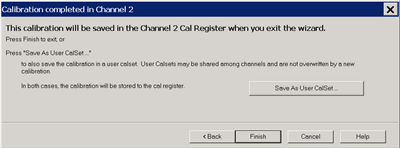Scalar Mixer/Converter Measurements (SMC)
The following information is unique to SMC:
See Also
Programming Commands
SMC Hardware Setup
SMC requires
a power meter/sensor, two sources, and
a Cal Kit or ECal module
Your DUT can be connected to any VNA ports. Learn
more.
Connect External
Source to the VNA GPIB Controller port. Learn how to Configure
an External Source.
Connect the 10 MHz
reference signal of an external source to the VNA. This
is especially important with SMC + Phase measurements.
Use either a GPIB power meter or USB power sensor.
Create an SMC Measurement
Press Setup
> Main
> Meas Class....
Select Scalar Mixer/Converter
+ Phase, then either:
An SC21 measurement is displayed.
SMC Parameters Offered
To select additional parameters to display, click Trace,
then click on a new trace, then select a parameter from the list.
Important
Note: Connecting your DUT to the VNA:
RF and IF
terminology is NOT used in FCA because the VNA does not know how
the DUT is labeled or how it will be used. Instead, the general
terms INPUT and OUTPUT are used.
INPUT and OUTPUT Frequencies are specified using the Mixer
Setup dialog box. |
The DUT input and output can be connected
to any VNA ports.
Note: Although there
are MANY configuration possibilities, the following images and
descriptions show ONLY a DUT connected to VNA ports 1 and 2.
Legend:
Black
are ratioed measurements (test port/reference receiver).
Green are unratioed measurements (either
a test port OR reference receiver). |
DUT Input to VNA
port 1
DUT Output
to VNA port 2 |
DUT Input to VNA
port 2
DUT Output
to VNA port 1 |
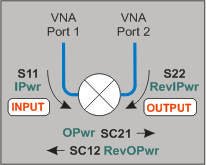
|
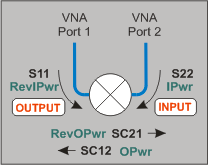
|
Ratioed
SC21
(Conversion Loss) Stimulus
at Input, response at Output (B/R1). SC12
(Reverse Isolation) Stimulus
at Output, response at Input (A/R2) S11
(Input match) Stimulus and response at
Input (A/R1) S22
(Output match) Stimulus
and response at Output (B/R2) |
Ratioed
SC12
(Conversion Loss) Stimulus
at Input, response at Output (A/R2) SC21
(Reverse Isolation) Stimulus
at Output, response at Input (B/R1) S11
(Output match) Stimulus and response at
Output (A/R1) S22
(Input match) Stimulus
and response at Input (B/R2) |
Unratioed
Absolute test port receiver
measurements. The receiver is automatically selected depending
on the DUT configuration.
IPwr
(Incident
Power) - stimulus
and response at Input. RevIPwr
(Reverse
Incident Power) -
stimulus and response at Output. OPwr
(Output
Power) - stimulus
at Input, response at Output. RevOPwr
(Reverse Output
Power) - stimulus
at Output, response at Input. |
|
|
SMC Mixer Setup
How to start the SMC Mixer Setup dialog |
Using
Hardkey/SoftTab/Softkey |
Using a mouse |
Press Sweep
> Main > SMC Setup... > Mixer
Setup tab. |
Click Stimulus Select Sweep Select SMC
Setup... Select Mixer
Setup |

|
The following SMC Mixer Setup dialog tabs are presented:
Speed Up SMC Measurements
Using default SMC settings, any calibrated SMC measurement requires
four sweeps. However, you can reduce the number of sweeps required by
selecting one or more of the following settings.
Use Nominal Incident Power
Click
Response, then Measure, then Use
Nominal Incident Power
Each data sweep of a fully corrected SMC transmission measurement actually
requires FOUR data sweeps. When you clear Use
Nominal Incident Power, the reference receiver (R1 or R2) does
NOT measure incident power. Instead, the incident power is assumed to
be at the level that was set with the Source
Power Calibration that is done as part of every SMC measurement. The
degradation in accuracy is very negligible if the input or output of your
DUT is well-matched.
This selection eliminates sweeps ONLY when both Include
Input Match AND Include Output
Match is cleared on the Cal Type dialog. Learn
more.
Apply
a Cal Set or SMC Cal Type
You can create an FCA measurement and apply an existing Cal Set as you
can with any VNA measurement. Learn about Cal
Sets. In addition, from a Cal Set, you can apply a specific SMC Cal
Type to an existing SMC measurement.
How to apply an SMC Cal Type
Create an SMC
measurement Calibrate or apply an existing SMC Cal Set,
then... |
Using
Hardkey/SoftTab/Softkey |
Press Cal
> Main > Correction Methods.... |

|
Correction
Method dialog box help |
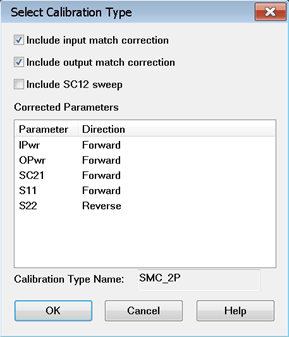
By default, each SMC calibration requires FOUR sweeps. Clearing
boxes will eliminate sweeps and speed up your SMC measurements.
The difference in speed is most noticeable when making fixed input
or fixed output measurements with an external LO source.
Include input match correction Check to perform a sweep to measure
and correct for INPUT match. Clear this box if the input of your
mixer is well-matched to the VNA, or if your setup does not permit
a valid S11 measurement.
Include output match correction Check to perform a sweep to measure
and correct for OUTPUT match. Clear this box if the output of
your mixer is well-matched to the VNA, or if your setup does not
permit a valid S22 measurement.
Include SC12 Sweep Check
to perform a reverse sweep to measure SC12.
When checked (default setting), a calibrated
SMC measurement sweeps in both forward (SC21) and reverse
(SC12) directions. Clear this checkbox to eliminate sweeps in
the reverse direction. This means that the following measurements
will NOT be corrected: SC12, RevOPwr, RevIPwr.
Corrected Parameters
Lists the parameters that can
be corrected given the boxes that are currently checked. These
parameters may not be currently measured.
Calibration Type Shows
the type of SMC Cal that will be applied given the boxes that
are currently checked.
Learn about Use Nominal
Incident Power
How many sweeps can be eliminated?
Setting |
Parameters
Learn
about parameter abbreviations |
#
of sweeps |
ALL
checked and clear Use
Nominal Incident Power |
IPwr,OPwr,RevIPwr,RevOPwr,SC21,SC12,S11,S22 |
4 Total |
Perform this action... |
to REMOVE these parameters... |
and these sweeps |
Clear "Include SC12" |
Remove
RevIPwr,RevOPwr,SC12 |
Removes
1 |
Clear "Include OUTPUT match |
Remove
S22 |
Removes
1 when Nominal is checked*. |
Clear "Include INPUT match" |
Remove
S11 |
Removes
1 when Nominal is checked*. |
Check "Use Nominal Incident Power" |
Remove
IPwr, RevIPwr |
May remove
up to 2* |
ALL cleared and check Nominal
Incident Power |
OPwr,SC21 |
1 Total |
*S11 shares a sweep with IPwr and
S22 shares a sweep with RevIPwr. Therefore, when Include
Input Match or Include
Output Match is checked, then checking Nominal incident
power does nothing.
VMC measurement sweeps can
NOT be eliminated. |
SMC Calibration
Overview
The SMC Calibration Wizard
guides you through this process.
When applying a Phase Reference cal set,
step 1 (power cal) is NOT performed.
Connect a power meter / sensor to VNA Port 1. At each
step of the input and output frequency, the VNA measures:
Perform two Full 2-port calibrations: one over
the INPUT frequencies and one over the OUTPUT frequencies of the DUT.
(If your DUT is a linear device, the calibration uses only the INPUT
frequency range.) Use either a mechanical calibration kit or an ECal
module.
For Mixers / Converters with High-output
Power
The Unknown Thru method is NOT valid when there is over 40 dB of combined
loss in the Unknown Thru and calibration path. In this case, the following
calibration and correction method is recommended.
On the Cal Wizard Modify
Frequency page, select Defined Thru or Flush Thru as the Thru
method. When using an ECal module, also on the Modify Frequency
page, disable (clear) Do Orientation
due to very low power.
After calibration, on the Correction
Method dialog, CLEAR the Include
output match correction and Include
SC12 Sweep check boxes. Check ONLY Include
input match correction.
To learn more about High-power measurements,
see our App Notes.
SMC Cal Wizard
The following dialog boxes are presented during an SMC Calibration.
Indented steps are optional.
How to Perform a SMC
Calibration
Create an SMC
measurement, then... |
Using
Hardkey/SoftTab/Softkey |
Using a mouse |
Press Cal
> Main > Smart Cal.... |
Click Response Select Cal Select Smart
Cal... |

|
SMC Calibration Setup
dialog box help |
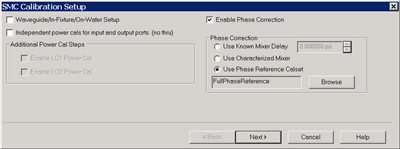
Allows you to review and change the settings for your SMC calibration.
Waveguide/In-fixture/On-Wafer
Setup Click Next
to launch the following Setup dialog box.
Independent power cals for
input and output ports (no thru) Check if a Thru
standard is NOT available. During the power cal, you will be prompted
to connect the power sensor to the Input, then the Output port.
Additional Power Cal Steps
Enable LO1 / LO2 Power Cal
Check when LO1 / LO2 is controlled (on the Mixer
Setup tab) to perform a Power Cal on the LO source(s).
Phase Correction
Enable
Phase Correction Check to enable Phase measurements.
Choose one of the following methods to specify the delay through
the characterized mixer. With the first two methods, the phase
delay through a Calibration Mixer is measured and compared to
the known delay, either entered, or stored in an *.S2PX file.
Use Known
Mixer Delay Enter the fixed, known, delay through
the calibration mixer. Use Characterized
Mixer Select, then browse to the *.S2P file that
characterizes the calibration mixer. Use an *.S2PX file
when making segmented SMC + Phase measurements. Learn
more. Use either of the following two methods to characterize
the Cal Mixer over the SMC measurement frequency range:
Use the Mixer
Characterization Wizard. (Click Response,
then Cal, then
Mixer Characterization
Wizard.) The Cal Mixer has the same requirements
as the VMC Cal Mixer.
Learn
more. In a calibrated VMC channel, measure the
group delay of the calibration mixer, then save to an
*.S2P or *.S2PX file. However, a characterized mixer is
required to calibrate the VMC channel.
|
Waveguide/In-fixture/On-Wafer
Setup dialog box help |
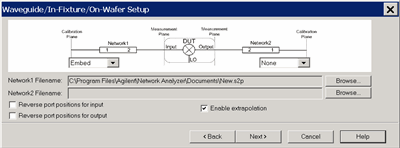
This dialog box appears ONLY if you checked the Waveguide/In-fixture/On-Wafer
Setup box in the previous Cal
Setup dialog.
Allows you to embed or de-embed circuit networks on the input
and output of your mixer under test.
For Network1 (Input) and Network2 (Output) select Embed,
De-embed, or None.
Browse Click to
navigate to the .S2P file that models the network to embed or
de-embed.
Reverse port positions for
input/output Check to cause the Fixture/Adapter to
be configured with Port 2 connected to the VNA and Port 1 to be
connected to the DUT. The image in the dialog is updated to reflect
that change.
Enable Extrapolation
Check (default setting) to apply a simple extrapolation
when the S2P file has a narrower frequency range than the channel.
The values for the first and last data points are extended in
either direction to cover the frequency range of the measurement.
A warning message is also displayed when extrapolation is necessary.
To Embed or De-embed
When you have a 2 port network that needs
to be connected between the Cal reference plane and the DUT
during the measurement, but it is NOT present during the calibration,
then that network has to be De-Embedded
from the port in question during the calibration. In other
words, De-Embedding in FCA calibration extends the calibration
reference plane to include the two port network. When you have a 2 port network that is included
as part of the calibration reference plane but has to be disconnected
during the measurement, then that 2-port network has to be
Embedded for the port
in question during the calibration. In other words, Embedding
in FCA calibration retracts the calibration reference plane
to exclude the two port network during the measurement.
|
Select
DUT Connectors and Cal Kits dialog box help |
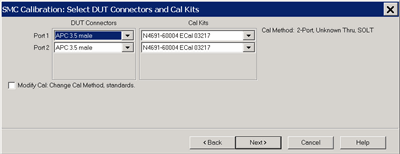
Allows you to specify the connector type and Cal Kit for each
DUT port.
Port n For each listed VNA
port, specify the DUT connector type and gender, and the Cal Kit
to use.
Note: If your DUT connectors
are:
Waveguide
Change the system impedance to 1 ohm before performing
a calibration. See Setting
System Impedance. Not listed
(male and female) Select Type
A as the connector type. Type A requires a calibration
kit file containing the electrical properties of the standards
used for calibration (see Calibration
kits). Unspecified
(like a packaged device) Select Type B
as the connector type. Type B requires a calibration kit file
containing the electrical properties of the standards used
for calibration (see Calibration
kits).
Modify Cal Check,
then click Next, to start
the Modify Frequency Cal
dialog.
Source Cal Settings
Click to start the Source
Cal Settings dialog. |
Modify Frequency Cal dialog
box help |

This dialog appears only when Modify
Cal is checked on the previous dialog.
The following selections are available
ONLY if using an ECal module.
Do orientation
When this box is checked (default) the VNA senses
the ECal model and direction in which the ECal module port is
connected to the VNA ports. If power to the ECal module is too
low, it will appear as if there is no ECal module connected. If
you use low power and are having this problem, clear this check
box to provide the orientation manually. Orientation occurs first
at the middle of the frequency range that you are calibrating.
If a signal is not detected, it tries again at the lowest frequency
in the range.
|
Power
Cal Settings dialog box help |
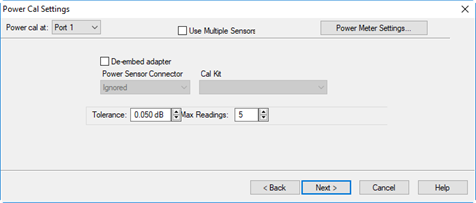
Note: A
Use Power Table checkbox
(not shown) is available when a mmWave SMC measurement is active.
Learn
more.
Power Cal at: Select
the source port for which a Power Calibration will be performed.
The source and receiver correction will be transferred to all
other sources and receivers involved in the S-parameter measurements.
Use
Multiple Sensors Check
this box when you want to use more than ONE power sensor to cover
the measurement frequency range. The dialog is replaced with the
Multiple Sensors dialog.
When "Use Multiple Sensors" is cleared (default setting),
connect only ONE sensor to the VNA.
Note: Use Multiple Sensors is a Licensed
Feature called Multiple-sensor Power Calibration for SMC/GCX.
Learn more about Licensed
Features.
Power Meter Settings
Click to start the standard Power
Meter Settings dialog.
De-embed (power sensor) adapter
When the power sensor connector is NOT the same type and
gender as the DUT connector for the specified port, then for optimum
accuracy, extra cal steps are required to measure and correct
for the adapter that is used to connect the power sensor to the
reference plane.
Clear
this box to NOT compensate for the added adapter.
Check
this box to perform extra calibration steps to measure and correct
for the adapter.
Then select the Power
Sensor Connector type and gender of the power sensor. "Ignored"
does NOT compensate for the added adapter, just as if the checkbox
were cleared.
When this connector matches the DUT
connector for the same port, then the VNA assumes that there is
no adapter. Extra cal steps are NOT required and the Cal Kit selection
is not available.
Otherwise, select the Cal
Kit to be used to calibrate at the adapter.
See Accuracy
Settings below. |
Specify
how the ECal module is connected dialog box help |
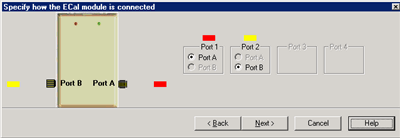
This dialog box appears when the Do
orientation checkbox in the previous Modify
Frequency dialog box is cleared.
Click the ECal Port that is connected to each VNA port. |
SMC
Calibration Steps dialog box help |

Power Level at which
to perform the Power Cal.
It is usually best to set power level to 0 dBm at the power
sensor because the power sensor is calibrated at that level. Lower
power levels will yield a slower and noisier calibration.
If an external component is used between the PNA-X test port
and the calibration reference plane, then adjust the power level
so that the power at the sensor is about 0 dBm if possible.
The current source attenuation value is shown on the dialog.
LO Power Cal (Optional) When enabled,
perform a Source Power Cal at the DUT LO connector. An LO must
already be selected. Learn
how. The power level of the LO source calibration is set on
the (LO)
Power Tab. |
Specify
delay dialog box help |

This dialog appears ONLY when Adapter
Removal or Unknown
Thru calibrations are performed.
The following values were estimated from the measurement. Most
of the time, they are adequate. However, for CW sweep or frequency
sweep with large step sizes, the accuracy of the values may be
improved.
Adapter delay To
improve this value, measure and record the delay of the adapter
with a dense step size. Enter that value here. The required precision
value is the accuracy that is required to characterize the delay
value.
Nominal phase offset
(Waveguide ONLY). To improve this value, measure and record
the phase offset of the Waveguide adapter with dense step size.
Enter that value here.
When one connector is coax and the other connector is waveguide,
the phase offset has an ambiguity of 180 degrees. For consistency,
the estimate provided here is always between 0 and 180 degrees.
You can change this estimate to any value between -180 degrees
and +180 degrees.
For SMC calibrations,
this dialog box appears twice: once for the input frequencies
and once for the output frequencies. The values can be slightly
different. |










